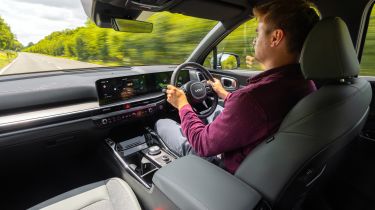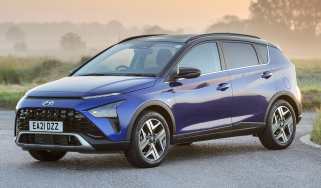Kia Sorento - Engines, performance and drive
The Sorento serves up a tidy driving experience through a strong and varied engine range, but the ride is on the firm side

It might be a big all-wheel drive SUV, but the Kia Sorento offers polished road manners and a surprising turn of pace. It rides on fully independent suspension and has a 35mm-longer wheelbase than the old model, which is intended to improve comfort levels. The ride feels cosseting enough, especially for a car in this class. There’s spongy damping to take the edge off, but you still get the odd jarring impact on poorly surfaced B-roads. Large speed bumps highlight just how softly-sprung the front of the Sorento is - as do tight turns.
Despite having a fairly relaxed suspension set up, the Sorento offers better body control than you expect through sweeping corners as well as a resistance to the floating feeling over undulations in the carriageway. For a seven-seat SUV, the Sorento largely feels composed and capable, the self-levelling rear suspension on the higher-spec cars helping maintain this when there’s a lot of weight on board. The steering does feel a little remote, with no feedback keeping you in touch with the front wheels, but the overall driving experience is well up to scratch for this sector.
When we pitted the Sorento Hybrid head-to-head against the Nissan X-Trail, the Nissan felt lighter and more lively. The X-Trail is shorter and turns more tightly than its rival too, so it’s easier to drive in tight spots than the Sorento. The Kia also had a firmer ride than the Nissan, plus its huge door mirrors almost certainly contribute to all of the wind noise we noticed at high speeds, but they do give the driver a great view of what’s going on behind the car.
Used - available now

2022 KIA
Sorento
51,703 milesAutomaticPetrol1.6L
Cash £27,763
2022 KIA
Sorento
37,674 milesAutomaticPetrol1.6L
Cash £26,700
2017 KIA
Sorento
100,000 milesAutomaticDiesel2.2L
Cash £12,000
2022 KIA
Sorento
32,512 milesAutomaticPetrol1.6L
Cash £26,300At least every Sorento has four-wheel drive, and for this generation Kia introduced its Terrain Mode function, which is essentially a set of driving modes that alter various parameters of the car’s set-up according to the terrain under the tyres. Land Rover’s Terrain Response system was clearly the inspiration.
The driver can select Mud, Snow and Sand modes, as well as introduce bespoke settings for the gearbox, ESC stability control and 4x4 system that are optimised for the different conditions. There are no locking differentials or low-range gearboxes, so don’t think of the Sorento as an extreme off-roader, but it should have enough muscle and grip to get you out of a muddy car park or up a snowy mountain road to a ski resort, should the need arise.
0-62mph acceleration and top speed
The Sorento engine line-up is strong with a selection of a diesel, plug-in hybrid and full-hybrid. The diesel comes in the shape of Kia’s 2.2-litre CRDi unit paired with an eight-speed dual-clutch gearbox. It’s the least powerful option in the range, producing 190bhp and 440Nm of torque in total. The engine has an aluminium block, making it 19.5kg lighter than the cast-iron block version that was the mainstay of the Mk3 Sorento range. The 0-62mph sprint takes 9.7 seconds, which is hardly slow for a large SUV, and it manages the Sorento’s highest top speed of 124mph.
The Sorento Hybrid has a 1.6-litre T-GDi turbocharged petrol engine, six-speed automatic gearbox and 1.49kWh battery pack feeding a 59bhp electric motor for a combined output of 212bhp and 367Nm of torque. Acceleration matches the diesel with 0-62mph done in exactly 9.7 seconds before topping out at 113mph.
Finally, the plug-in hybrid Sorento PHEV has the same engine and gearbox combo as the self-charging hybrid, but the battery is 13.8kWh and the electric motor offers a 90bhp boost. That makes for an output of 248bhp combined with a healthy 367Nm of torque. The 0-62mph dash takes 8.8 seconds and the top speed is 113mph.
The self-charging hybrid powertrain seems like the one to choose for buyers who aren’t bothered about accessing the substantial company car tax breaks that come with the plug-in hybrid, and who also don’t need the diesel’s muscle. Its powertrain is pretty refined unless you push it hard - where it can sound a little gruff, yet it’s also punchy with the electrical assistance at low speeds. The PHEV is all but silent in EV mode, but can be slow to respond when you put your foot down as the system works out which power source to use. There’s also a tendency for the petrol engine to cut in and out when you’re at a standstill.
The diesel would have been the default choice for a big SUV a few years ago and its strength will still make it the preferred option for those who plan on making their Sorento work hard on towing or light off-roading duties. It’s a smooth unit that eases the power on in a gentle fashion, and it only gets loud at the top end of the rev range. The eight-speed gearbox works very well, its changes all but imperceptible most of the time, making the diesel Sorento a convincing package. We recommend leaving the Sorento in the ‘Standard’ or ‘Smart’ drive modes as the ‘Sport’ mode stays one or two gears lower - affecting fuel efficiency and not adding too much to the performance. We’d also suggest ignoring the manual gearshift paddles behind the wheel as they’re pretty slow to respond.











